1994 OLDSMOBILE SILHOUETTE oil temperature
[x] Cancel search: oil temperaturePage 12 of 276
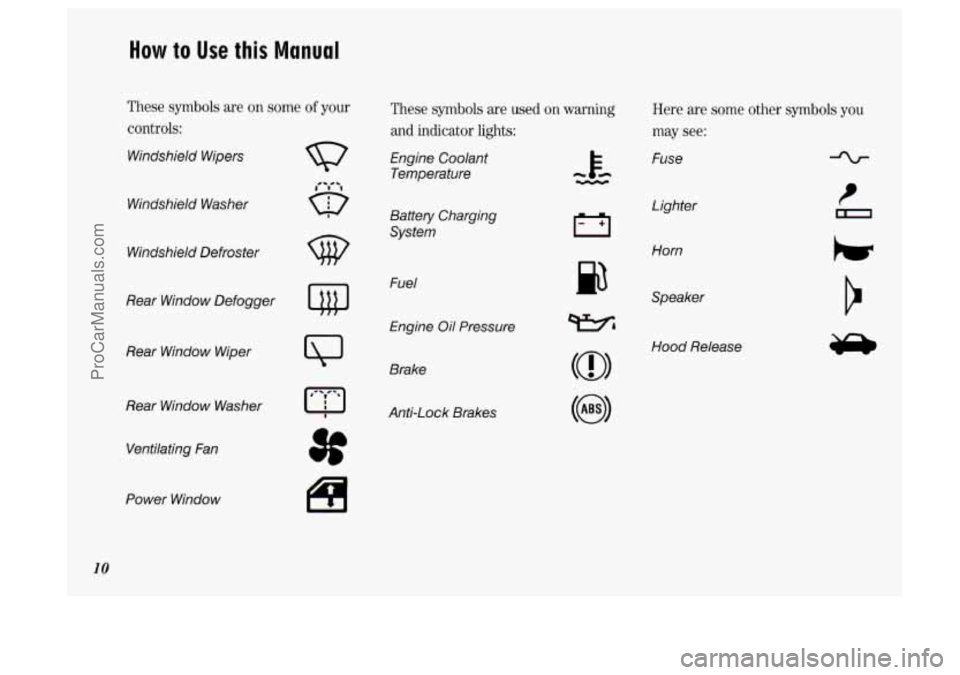
How to Use this Manual
These symbols are on some of your
controls:
Windshield Wipers
Windshield Washer
w
Windshield Defroster
Rear Window Defogger
Rear Window Wiper
Rear Window Washer Ventilating Fan
Power Window
10
3f
These symbols are used on warning
and indicator lights:
Engine Coolant Temperature
Battery Charging
System
Fuel
Engine
Oil Pressure
Brake
AntXock Brakes
p3
Here are some other symbols you
may see:
Fuse
Lighter
Horn
Speaker
Hood Release
ProCarManuals.com
Page 104 of 276
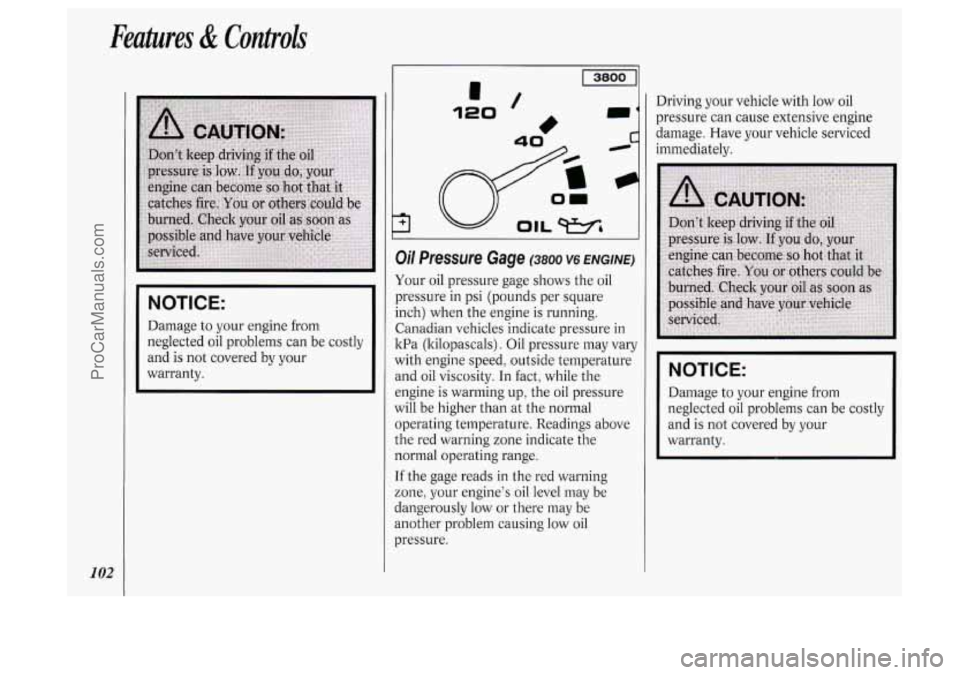
Features & Controls
102
NOTICE:
Damage to your engine from
neglected oil problems can be costly
and
is not covered by your
warranty.
I I
3il Pressure Gage (3800 v6 ENGINE)
four oil pressure gage shows the oil
x-essure
in psi (pounds per square
nch) when the engine is running.
Zanadian vehicles indicate pressure in
vith engine speed, outside temperature
md oil viscosity. In fact, while the
mgine is warming up, the oil pressure
vi11 be higher than at the normal
Iperating temperature. Readings above
.he red warning zone indicate the
lormal operating range.
.f the gage reads in the red warning
:one, your engine's oil level may be
langerously low or there may be
mother problem causing low oil
xessure. Driving
your vehicle with low oil
pressure can cause extensive engine
damage. Have your vehicle serviced
immediately.
NOTICE:
Damage to your engine from
neglected oil problems can be costly
and is not covered by your
warranty.
ProCarManuals.com
Page 194 of 276
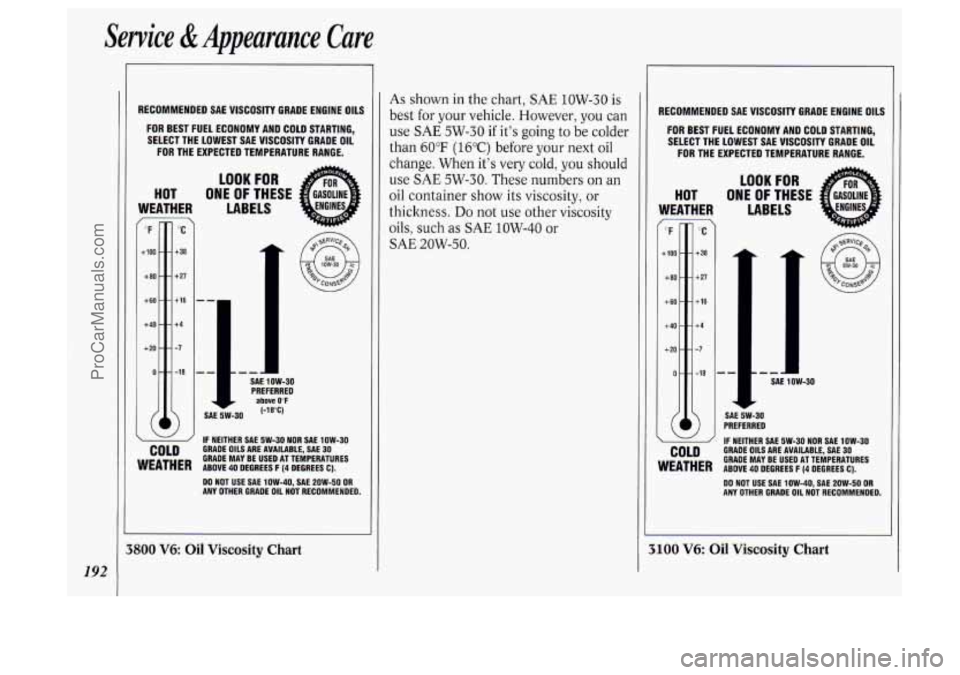
Service &Appearance Care
192
RECOMMENDED SAE VISCOSITY GRADE ENGINE OILS
FOR BEST FUEL ECONOMY AND COLD STARTING,
SELECT THE LOWEST SAE VISCOSITY GRADE OIL
FOR THE EXPECTED TEMPERATURE RANGE.
LOOK FOR
HOT ONE OF THESE
WEATHER LABELS
t100 .
+80 -
+60 -
+40 -
+20 -
0-
“C
+38
+27
+16
+4
-7
-18
COLD
SAE 1OW-30 PREFERRED above 0°F
SAE 5W-30 (-18°C)
1 IF NEITHER SAE 5W-30 NOR SAE 1OW-30 GRADE OILS ARE AVAILABLE, SAE 30 GRADE MAY BE USED AT TEMPERATURES WEATHER ABOVE 40 DEGREES F (4 DEGREES c).
DO NOT USE SAE 1OW-40, SAE 2OW-50 OR ANY OTHER GRADE OIL HOT RECOMMENDED.
2300 V6: Oil Viscosity Chart
As shown in the chart, SAE 1OW-30 is
best for your vehicle. However, you can
use SAE 5W-30 if it’s going to be colder
than
60°F (16°C) before your next oil
change. When it’s very cold,
you should
use
SAE 5W-30. These numbers on an
oil container show its viscosity, or
thickness.
Do not use other viscosity
oils, such
as SAE 1OW-40 or
SAE 20W-50.
RECOMMENDED SAE VISCOSITY GRADE ENGINE OILS
FOR BEST FUEL ECONOMY AND COLD STARTING,
SELECT THE LOWEST SAE VISCOSITY GRADE OIL
FOR THE EXPECTED TEMPERATURE RANGE.
‘-’ F
+loo
+80
+ 60
+40
+20
0
“C
+38
+ 27
+16
+4
-7
-18
LOOK FOR
LABELS
HOT ONE
OF THESE
- SAE I 1
OW-30
SAE 5W-30 PREFERRED
IF NEITHER SAE
5W-30 NOR SAE 1OW-30 GRADE OILS ARE AVAILABLE. SAE 30 COLD
WEATHER ABOVE 40 DEGREES F (4 DEGREES c).
GRADE
MAY BE USED AT TEMPERATURES
DO NOT USE SAE
1OW-40, SAE 2OW-50 OR ANY OTHER GRADE OIL NOT RECOMMENDED.
3100 V6: Oil Viscosity Chart
ProCarManuals.com
Page 197 of 276
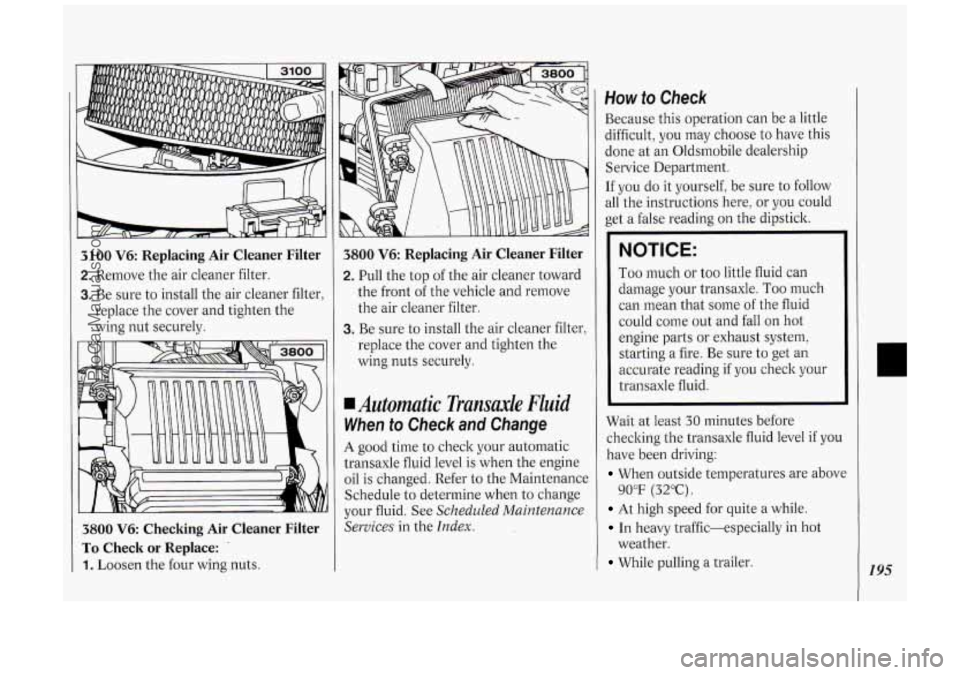
3100 V6: Replacing Air Cleaner Filter
2. Remove the air cleaner filter.
3. Be sure to install the air cleaner filter,
replace the cover and tighten the
wing nut securely.
3800 V6 Checking Air Cleaner Filter
To Check or Replace: .
1. Loosen the four wing nuts.
3800 V6: Replacing Air Cleaner Filter
2. Pull the top of the air cleaner toward
the front of the vehicle and remove
the air cleaner filter.
3. Be sure to install the air cleaner filter,
replace the cover and tighten the
wing nuts securely.
Automatic Transaxle Fluid
When to Check and Change
A good time to check your automatic
transaxle fluid level is when the engine
oil is changed. Refer
to the Maintenance
Schedule to determine when to change
your fluid. See
Scheduled Maintenance
Services
in the Index.
How to Check
Because this operation can be a little
difficult, you may choose to have this
done at an Oldsmobile dealership
Service Department.
If you do it yourself, be sure to follow
all the instructions here, or you could
get a false reading on the dipstick.
NOTICE:
Too much or too little fluid can
damage your transaxle.
Too much
can mean that some of the fluid
could come out and fall on hot
engine parts or exhaust system,
starting a fire. Be sure to get an
accurate reading if you check your
transaxle fluid.
Wait at least
30 minutes before
checking the transaxle fluid level
if you
have been driving:
When outside temperatures are above
At high speed for quite a while.
In heavy traffic-especially in hot
While pulling a trailer.
90°F (32°C).
weather.
195
ProCarManuals.com
Page 199 of 276
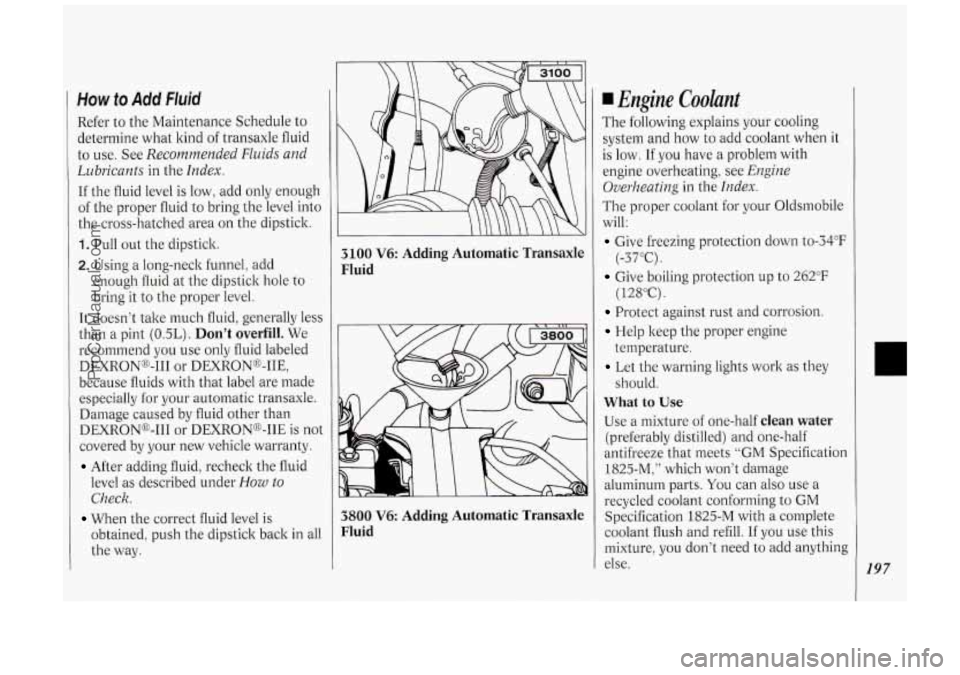
How to Add Fluid
Refer to the Maintenance Schedule to
determine what kind of transaxle fluid
to use. See
Recommended Fluids and
Lubricants
in the Index.
If the fluid level is low, add only enough
of the proper fluid to bring the level into
the cross-hatched area
on the dipstick.
1. Pull out the dipstick.
2. Using a long-neck funnel: add
enough fluid at the dipstick hole to
bring it to the proper level.
It doesn’t take much fluid, generally less
than a pint
(OSL). Don’t overfill. We
recommend you use only fluid labeled
DEXRONo-I11 or DEXRON@-IIE,
because fluids with that label are made
especially for your automatic transaxle.
Damage caused by fluid other than
DEXRONo-I11 or DEXRONB-IIE is not
covered by your new vehicle warranty.
After adding fluid, recheck the fluid
level as described under
How to
Check.
obtained, push the dipstick back in all
the way.
When the correct fluid level is
3100 V6: Adding Automatic Transaxle
Fluid
3800 V6: Adding Automatic Transaxle
Fluid
Engine Coolant
The following explains your cooling
system and how to add coolant when it
is
low. If you have a problem with
engine overheating, see
Engine
Overheating
in the Index.
The proper coolant for your Oldsmobile
will:
Give freezing protection down to-34”F
Give boiling protection up to 262°F
Protect against rust and corrosion.
Help keep the proper engine
Let the warning lights work as they
What to Use
Use a mixture of one-half clean water
(preferably distilled) and one-half
antifreeze that meets
“GM Specification
1825-M:” which won’t damage
aluminum parts.
You can also use a
recycled coolant conforming to
GM
Specification 1825-M with a complete
coolant flush and refill.
If you use this
mixture,
you don’t need to add anything
else.
(-37°C).
( 12SoC).
temperature. should.
197
ProCarManuals.com
Page 228 of 276

226
Service & Appearance Care
Engine Specifications
VIN Engine Code ...........................................
Type ................................................................
Displacement ..................................................
Compression Ratio .......... ....... .. .. .. ..... .............
Firing Order ...................... .. ....................... ... ..
Thermostat Temperature Specification . . . . . . . . .
31 00 V6 Engine
D
V6
3.1 Liters
8.5:1
1-2-3-4-5-6
195°F (91°C)
3800 V6 Engine
1
V6
3.8 Liters
9.0:
1
1-6-5-4-3-2
195°F (91°C)
Normal Maintenance Replacement Parts
Air Cleaner Element ....................................... AC Type A-773C AC Type A-974C
Engine
Oil Filter ............................................. AC Type PF-51 AC Type PF-47
PCV Valve
................. .. ................... .... ... . . . ...... AC Type CV-789C AC Type CV-892C
Spark Plugs
...... . , . . . . . . . . . . . . .. . . . . . . .. . . . . . . , . . . . . . . . . . . . . . . . AC Type oR43TS AC Type 41-600
Remote Lock Control Batteries (2)
............... DL 2016 DL 2016
Gap: 0.045
inch (1.14
mm) Gap: 0.060 inch (1.52 mm)
ProCarManuals.com
Page 236 of 276
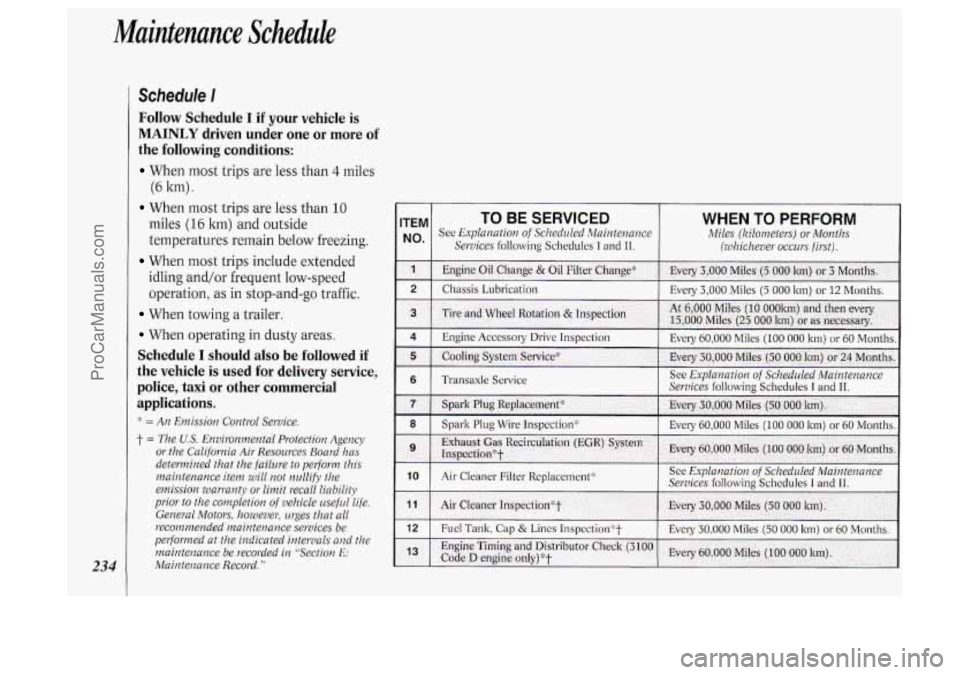
Muintenunce Schedule
234
Schedule I
Follow Schedule I if your vehicle is
MAINLY driven under one or more of
the following conditions:
When most trips are less than 4 miles
When most trips are less than 10
(6
ltm)
.
miles (16 ltrn) and outside
temperatures remain below freezing.
When most trips include extended
idling and/or frequent low-speed
operation, as in stop-and-go traffic.
When towing a trailer.
When operating in dusty areas.
Schedule I should also be followed if
the vehicle is used for delivery service,
police, taxi
or other commercial
applications.
::: = An Emission Control Service.
j- = The U.S. Emiyonmental Protection Agency
or the California Air Resources Board has
determined that the failure
to pelform this
maintenance item will
not nullify the
emission warranty or limit recall liability
prior
to the completion of vehicle useful life.
General Motors, however, urges that all
recommended maintenance services be
pelformed at the indicated intervals and the
maintenance be recorded in “Section
E:
Maintenance Record.”
ITEM TO BE SERVICED WHEN TO PERFORM
No* See Explanation of Scheduled Maintenance Miles (Kilometers) or Months
Services
following Schedules I and 11. (whichever occurs firsl).
1 Engine Oil Change & Oil Filter Change* Every 3,000 Miles (5 000 km) or 3 Montl~s..
2 Chassis Lubrication Every 3,000 Miles (5 000 lm) or 12 Months.
ProCarManuals.com
Page 240 of 276
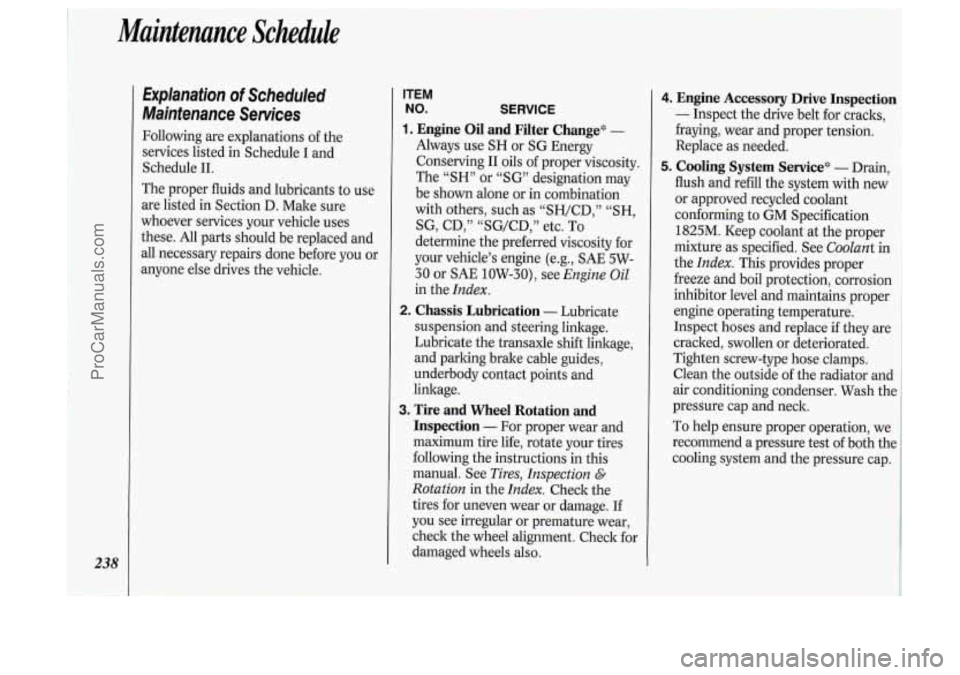
Maintenance Schedule
238
Explanation of Scheduled
Maintenance Services
Following are explanations of the
services listed in Schedule I and
Schedule 11.
The proper fluids and lubricants to use
are listed in Section D. Make sure
whoever services your vehicle uses
these. All parts should be replaced and
all necessary repairs done before you or
anyone else drives the vehicle.
ITEM
NO. SERVICE
1. Engine Oil and Filter Change* -
Always use SH or SG Energy
Conserving
I1 oils of proper viscosity.
The
“SH” or “SG” designation may
be shown alone
or in combination
with others, such as “SH/CD,”
“SH,
SG, CD,” “SG/CD,” etc. To
determine the preferred viscosity for
your vehicle’s engine (e.g.,
SAE 5W-
30 or SAE 10W-30), see
Engine Oil
in the Index.
2. Chassis Lubrication - Lubricate
suspension and steering linkage.
Lubricate the transaxle shift linkage,
and parking brake cable guides,
underbody contact points and
linkage.
3. Tire and Wheel Rotation and
Inspection
- For proper wear and
maximum tire life, rotate your tires
following the instructions in this
manual. See
Tires, Inspection E.
Rotation in the Index. Check the
tires for uneven wear
or damage. If
you see irregular or premature wear,
check the wheel alignment. Check for
damaged wheels also.
Engine Accessory Drive Inspection
- Inspect the drive belt for cracks,
fraying, wear and proper tension.
Replace as needed.
I
Cooling System Servicee - Drain,
flush and refill the system with new
or approved recycled coolant
conforming to GM Specification
I
1825M. Keep coolant at the proper 1
mixture as specified. See Coolant in
the
Index. This provides proper
freeze and boil protection, corrosion
I
inhibitor level and maintains proper ’
engine operating temperature.
Inspect hoses
and replace if they are
cracked, swollen or deteriorated.
Tighten screw-type hose clamps.
Clean the outside of the radiator and
air conditioning condenser. Wash tht
pressure cap and neck.
To help ensure proper operation, we
recommend
a pressure test of both the
cooling system and the pressure cap.
ProCarManuals.com